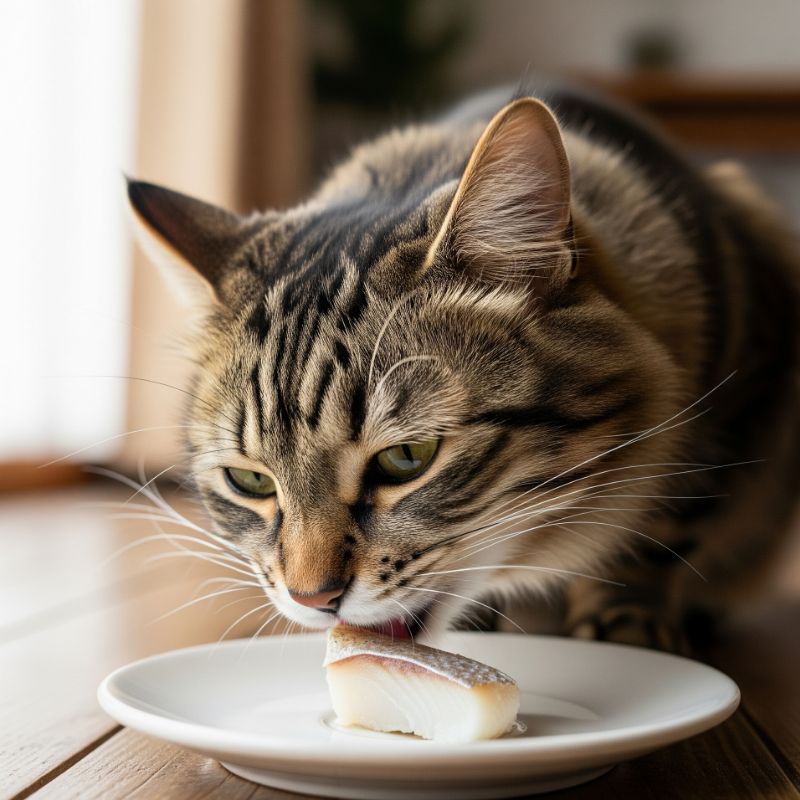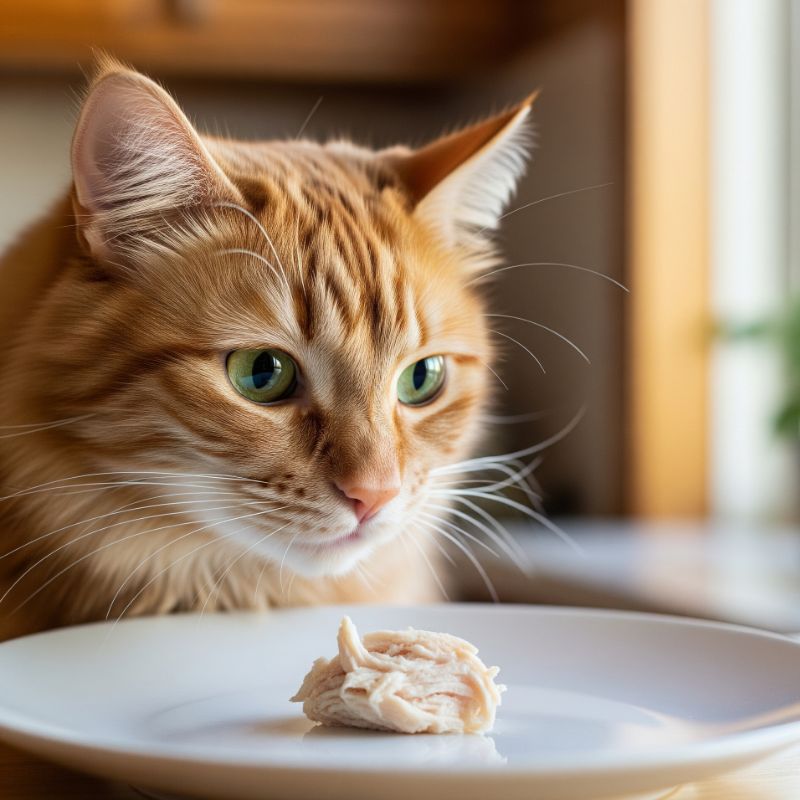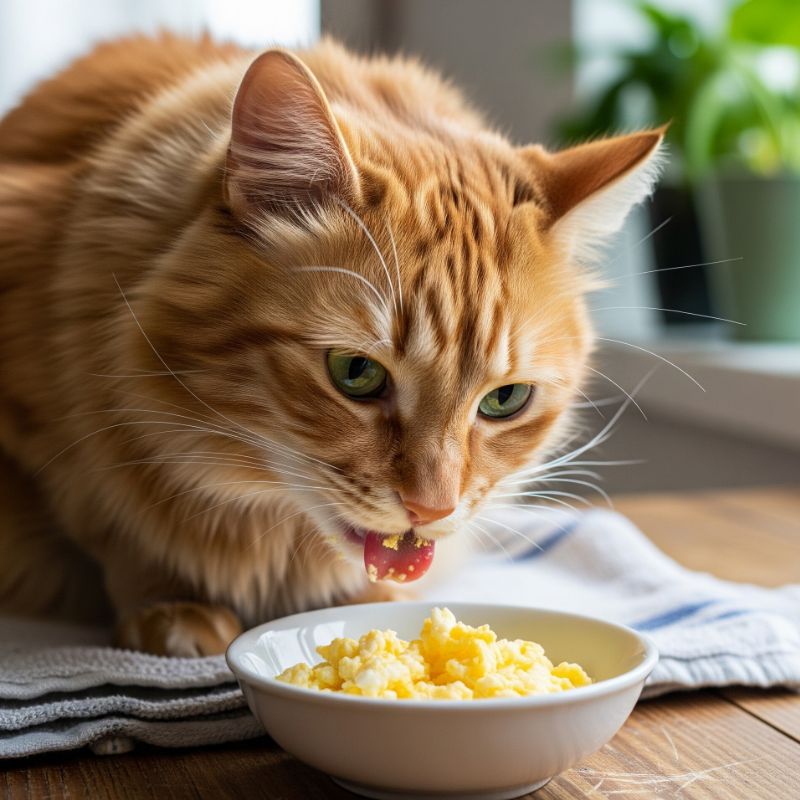It’s a familiar scenario for any cat owner: you’re eating a meal, and your cat begins to show a keen interest, hoping for a share. While sharing our food can feel like a bonding experience, a cat’s nutritional needs are vastly different from our own. So, what can cats eat that are human food? The answer involves a careful selection of safe options and a strict avoidance of many others. This guide will provide a clear list of cat-safe human foods and the critical rules you must follow before sharing anything from your plate.
what can cats eat that are human food?
When considering what cats can eat that are human food, it’s crucial to remember they are obligate carnivores with unique dietary needs. While many items from our kitchen are dangerous, a select few can be shared safely as an occasional treat. The best and safest options are always plain, cooked proteins like chicken, turkey, and fish, which align with their natural diet. Small amounts of cooked eggs are also an excellent, protein-rich snack. Some vegetables and a few fruits can be offered in tiny portions, but the list of toxic foods to avoid—such as onions, garlic, chocolate, and grapes—is long and critical to know. The golden rule is to always serve human food unseasoned, fully cooked, and in very small quantities, ensuring it never replaces their nutritionally complete cat food.
What to Know Before Sharing Any Human Food?
Before we list the safe foods, it’s essential to understand the non-negotiable rules of sharing. A cat’s digestive system is sensitive, and what seems harmless to us can be problematic for them. Following these guidelines, a core principle at petomiz, ensures your cat’s safety.
| Rule | Explanation |
|---|---|
| Treats Are Not Meals | Human food should only be an occasional treat, making up no more than 10% of their daily caloric intake. |
| Always Cooked, Never Raw | Raw meat, fish, and eggs carry the risk of Salmonella and E. coli. Always cook them thoroughly. |
| Keep It Plain and Simple | Never add salt, onions, garlic, spices, or heavy oils and butters. These are often toxic. |
| Serve in Small Pieces | Cut all food into small, bite-sized pieces to prevent choking. |
The Best Meats and Fish for Your Cat?
As obligate carnivores, cats thrive on animal-based protein. This makes plain, cooked meats the best and safest category of human food for them.
- Chicken & Turkey: Cooked, unseasoned, and boneless poultry is an excellent source of lean protein.
- Lean Beef & Lamb: Small amounts of cooked lean beef, lamb, or other red meats are also safe. Avoid fatty cuts.
- Cooked Fish: Fish like salmon and tuna are rich in omega-3 fatty acids. However, they should only be given occasionally due to mercury concerns and the risk of thiamine deficiency. Never feed raw fish.
What About Eggs and Dairy? A Cautious Yes and No
This category is mixed. While one is a great source of protein, the other is often problematic for felines. Many owners ask can cats eat eggs, and the answer is a resounding yes—as long as they are fully cooked (scrambled or boiled) and plain. They are packed with protein and amino acids. Conversely, the question can cats eat cheese is met with more caution. Most adult cats are lactose intolerant, meaning cheese and other dairy products can cause digestive upset like diarrhea. A tiny piece of hard cheese might be tolerated, but it’s generally best to avoid it.
Can Cats Eat Fruits and Vegetables?
While not a necessary part of their diet, some fruits and vegetables are safe for cats in tiny amounts and can provide fiber and vitamins.
- Safe Vegetables: Steamed carrots, broccoli, green beans, or plain canned pumpkin can be good for digestion.
- Safe Fruits: A small piece of cantaloupe, or asking can cats eat watermelon, reveals hydrating options your cat might enjoy. Just remember to remove seeds and rinds.
Grains and Breads: Are They Ever a Good Idea?
Generally, cats have no nutritional need for grains. However, some are safe in very small quantities. Small amounts of cooked oats or corn can be okay, but they are mostly empty calories. The question can cats eat bread has a similar answer: a tiny piece of plain, baked bread is not toxic, but it provides no benefits. Raw bread dough, however, is a medical emergency as it can cause alcohol poisoning and severe bloating.
Foods to AVOID at All Costs: A Critical Warning List
This is the most important section. Some human foods are extremely toxic to cats and must never be given. This list is not exhaustive, so always research a food before sharing.
- Onions, Garlic, Chives, & Leeks: These damage red blood cells and can cause anemia.
- Grapes & Raisins: Highly toxic and can cause acute kidney failure. The question can cats eat grapes should always be answered with a firm “no.”
- Alcohol: Extremely toxic, even in tiny amounts.
- Caffeine: Found in coffee, tea, and soda, it can be fatal to cats.
- Xylitol: An artificial sweetener found in many products (like some peanut butters) that is deadly.
It is critical to be aware of these dangers. For example, many people don’t know that the answer to can cats eat chocolate is absolutely not, as it contains both caffeine and theobromine, which are highly toxic to felines. For a comprehensive list of toxic foods, consult a resource like the ASPCA Animal Poison Control.
How to Safely Introduce New Human Foods to Your Cat
If you decide to offer a safe human food, always do it slowly and carefully to avoid any negative reactions.
- Start Small: Offer just a tiny, thumbnail-sized piece the first time.
- Introduce One Food at a Time: Wait a day or two before trying another new food to ensure the first one didn’t cause any digestive upset.
- Watch for a Reaction: Keep an eye out for any signs of an upset stomach, like vomiting or diarrhea. If you see any, do not offer that food again.
- Make it a Treat, Not a Habit: Remember that these are special-occasion snacks, not a new part of their daily diet.
Conclusion
So, what can cats eat that are human food? The safest bet is always to stick to plain, cooked meats. While a few other items can be shared in moderation, the long list of potential dangers means that caution should always be your top priority. By understanding the rules and prioritizing their species-specific diet, you can enjoy the occasional bonding moment of sharing a treat without compromising your cat’s health and well-being.
Frequently Asked Questions About Human Food for Cats
Here are quick answers to some common questions about sharing your food with your feline friend. This information is for general guidance and is not a substitute for veterinary advice.
1. What’s the one best human food to give a cat as a treat?
The single best and safest human food treat for a cat is a small piece of unseasoned, cooked chicken or turkey. It’s a high-quality protein that aligns perfectly with their natural dietary needs.
2. How much human food can I give my cat?
Treats, including human food, should never make up more than 10% of your cat’s total daily calorie intake. For most cats, this means just a few small pieces, about the size of a thumbnail.
3. Why does my cat beg for human food if it’s bad for them?
Cats are often attracted to the smell and novelty of your food, especially foods high in fat and protein. Their begging is a sign of curiosity and desire, not a sign that the food is actually good for them.



